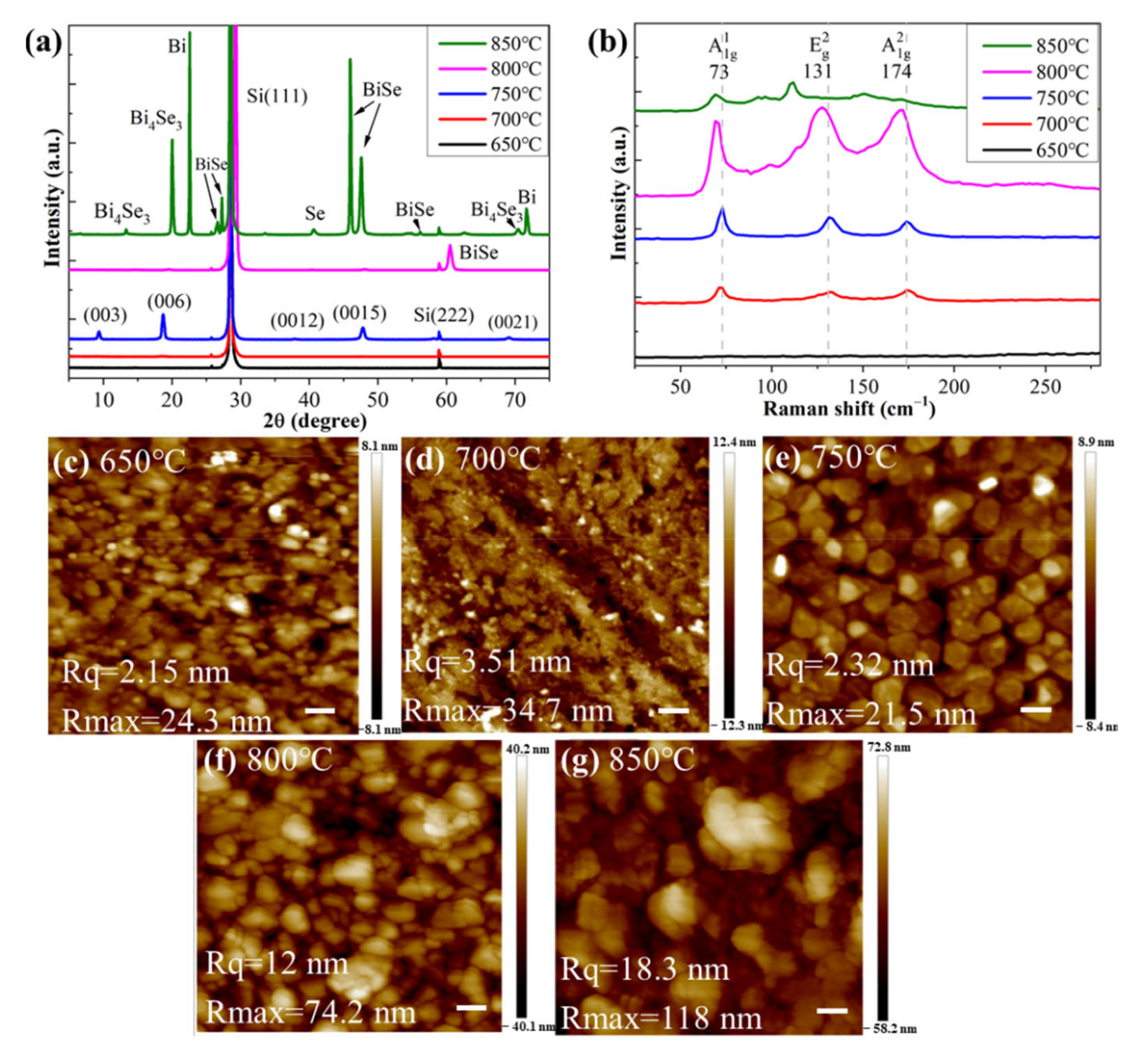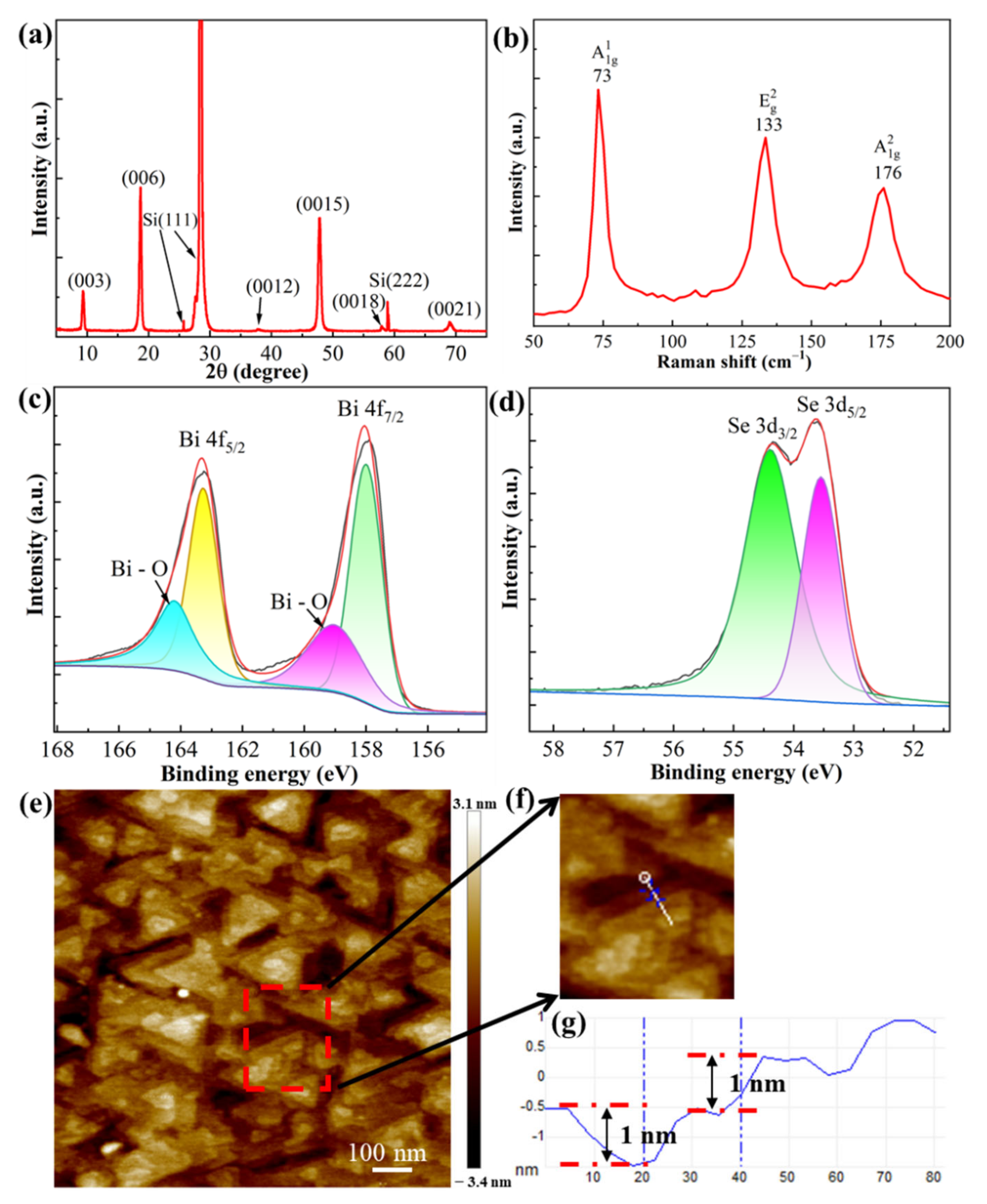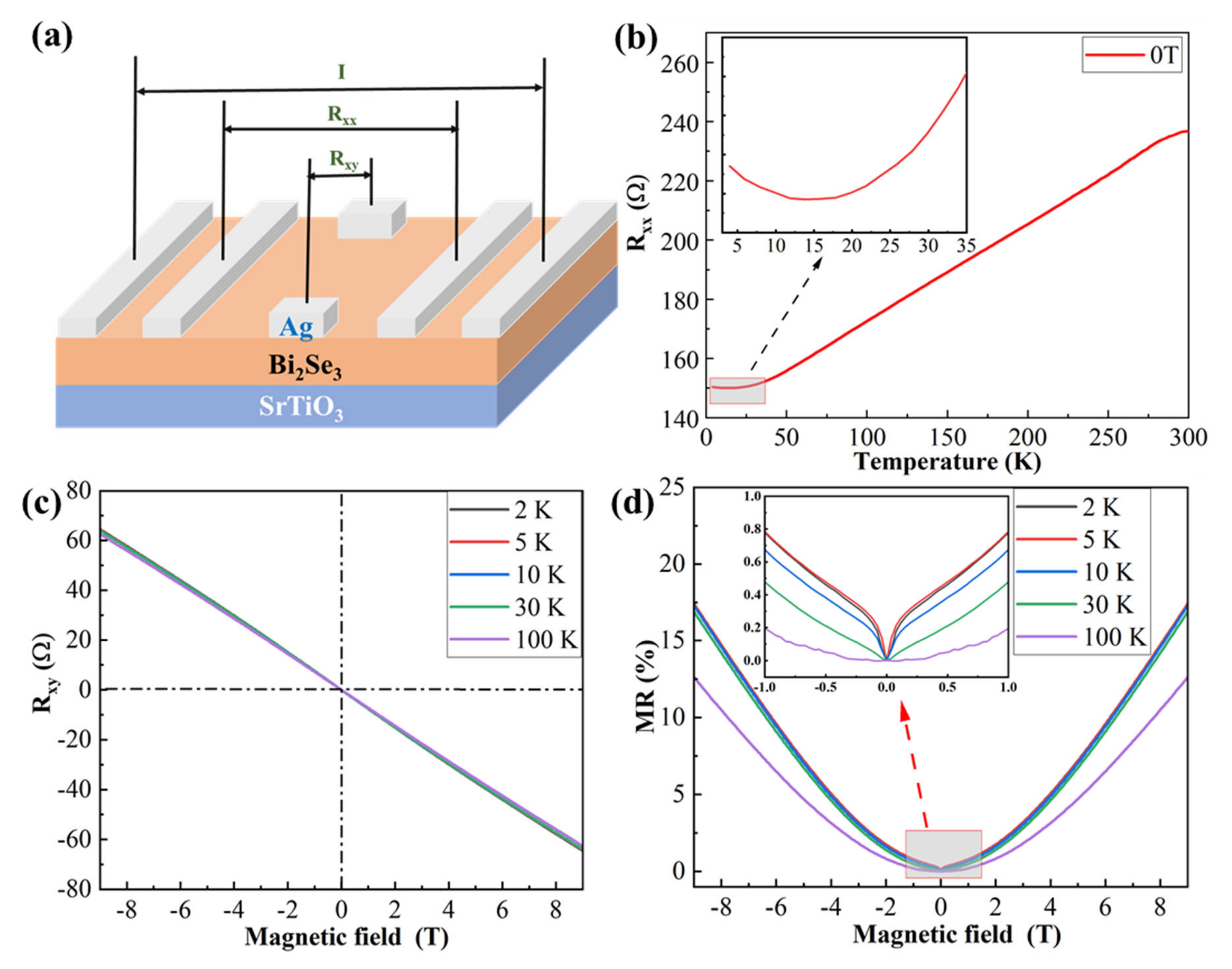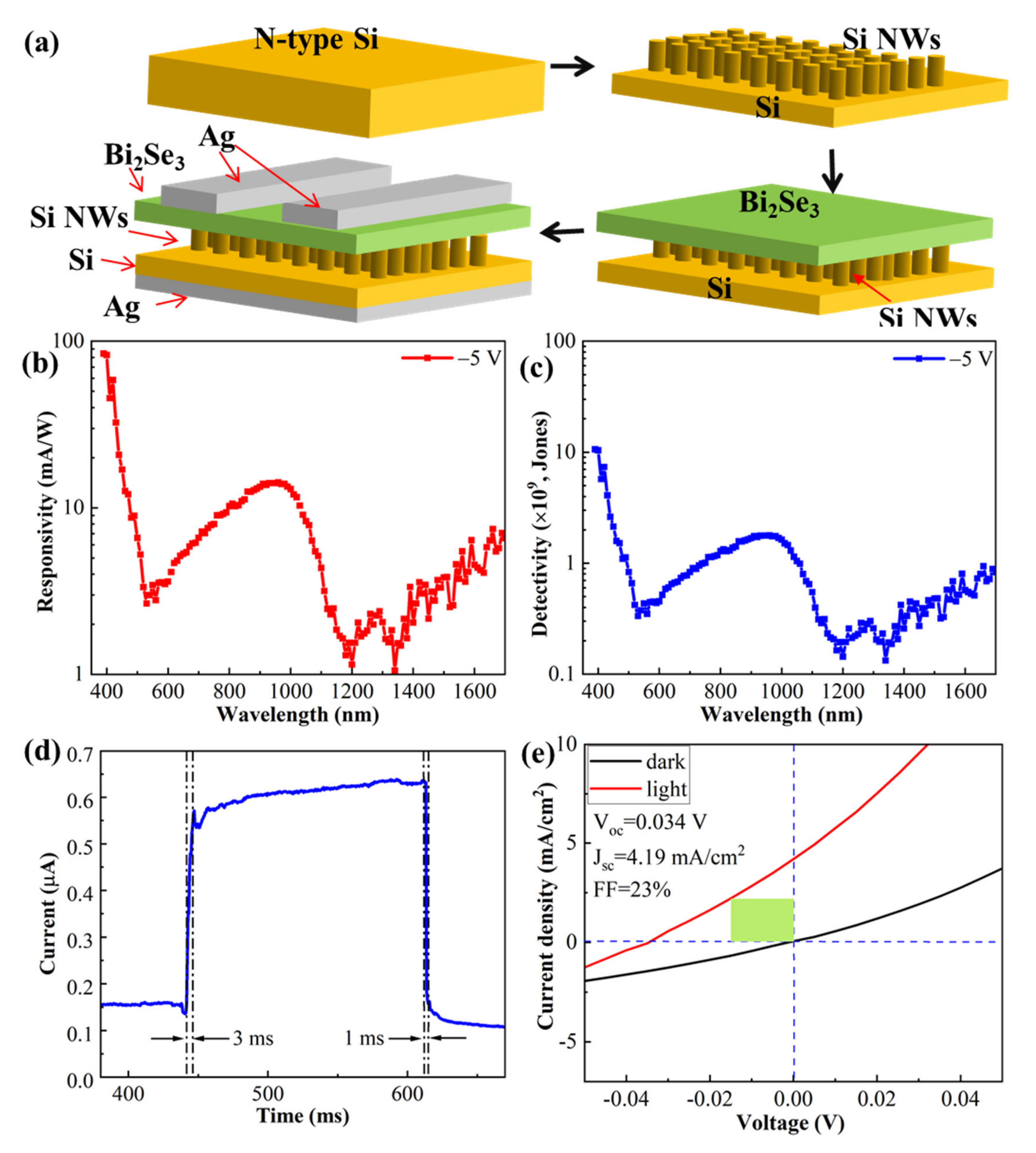Fabrication and Characterization of a Self-Powered n-Bi2Se3/p-Si Nanowire Bulk Heterojunction Broadband Photodetector
Abstract
:1. Introduction
2. Materials and Methods
2.1. Sample Preparation
2.1.1. Preparation of Bi2Se3 Thin Films
2.1.2. Preparation of Si NWs
2.1.3. Fabrication of the n-Bi2Se3/p-Si NWs Photodetector
2.2. Sample and Device Testing Method
3. Results and Discussion
3.1. Growth and Characterization of Bi2Se3 Films
3.2. Analysis of Electrical Properties of the Samples
3.3. Results Analysis of Bi2Se3/Si NWs Heterojunction
3.4. Performance of the n-Bi2Se3/p-Si NWs Photodetector
4. Conclusions
Supplementary Materials
Author Contributions
Funding
Data Availability Statement
Acknowledgments
Conflicts of Interest
References
- Chitara, B.; Panchakarla, L.S.; Krupanidhi, S.B.; Rao, C.N. Infrared photodetectors based on reduced graphene oxide and graphene nanoribbons. Adv. Mater. 2011, 23, 5419–5424. [Google Scholar] [CrossRef] [PubMed]
- Lin, X.; Wang, F.; Shan, X.; Miao, Y.; Chen, X.; Yan, M.; Zhang, L.; Liu, K.; Luo, J.; Zhang, K. High-performance photodetector and its optoelectronic mechanism of MoS2/WS2 vertical heterostructure. Appl. Surf. Sci. 2021, 546, 149074. [Google Scholar] [CrossRef]
- Khan, M.F.; Ahmed, F.; Rehman, S.; Akhtar, I.; Rehman, M.A.; Shinde, P.A.; Khan, K.; Kim, D.K.; Eom, J.; Lipsanen, H.; et al. High performance complementary WS2 devices with hybrid Gr/Ni contacts. Nanoscale 2020, 12, 21280–21290. [Google Scholar] [CrossRef] [PubMed]
- Konig, M.; Wiedmann, S.; Brune, C.; Roth, A.; Buhmann, H.; Molenkamp, L.W.; Qi, X.L.; Zhang, S.C. Quantum spin hall insulator state in HgTe quantum wells. Science 2007, 318, 766–770. [Google Scholar] [CrossRef] [Green Version]
- Hsieh, D.; Qian, D.; Wray, L.; Xia, Y.; Hor, Y.S.; Cava, R.J.; Hasan, M.Z. A topological Dirac insulator in a quantum spin Hall phase. Nature 2008, 452, 970–974. [Google Scholar] [CrossRef] [PubMed] [Green Version]
- Kong, D.; Koski, K.J.; Cha, J.J.; Hong, S.S.; Cui, Y. Ambipolar field effect in Sb-doped Bi2Se3 nanoplates by solvothermal synthesis. Nano. Lett. 2013, 13, 632–636. [Google Scholar] [CrossRef] [PubMed]
- Hsieh, D.; Xia, Y.; Qian, D.; Wray, L.; Dil, J.H.; Meier, F.; Osterwalder, J.; Patthey, L.; Checkelsky, J.G.; Ong, N.P.; et al. A tunable topological insulator in the spin helical Dirac transport regime. Nature 2009, 460, 1101–1105. [Google Scholar] [CrossRef] [PubMed] [Green Version]
- Kane, C.L.; Mele, E.J. Quantum spin Hall effect in graphene. Phys. Rev. Lett. 2005, 95, 226801. [Google Scholar] [CrossRef] [Green Version]
- Manoharan, H.C. Topological insulators: A romance with many dimensions. Nat. Nanotechnol. 2010, 5, 477–479. [Google Scholar] [CrossRef]
- Peng, H.; Dang, W.; Cao, J.; Chen, Y.; Wu, D.; Zheng, W.; Li, H.; Shen, Z.X.; Liu, Z. Topological insulator nanostructures for near-infrared transparent flexible electrodes. Nat. Chem. 2012, 4, 281–286. [Google Scholar] [CrossRef]
- Pesin, D.; MacDonald, A.H. Spintronics and pseudospintronics in graphene and topological insulators. Nat. Mater. 2012, 11, 409–416. [Google Scholar] [CrossRef] [PubMed]
- Hasan, M.Z.; Kane, C.L. Colloquium: Topological insulators. Rev. Mod. Phys. 2010, 82, 3045–3067. [Google Scholar] [CrossRef] [Green Version]
- Gupta, G.; Jalil, M.B.; Liang, G. Evaluation of mobility in thin Bi2Se3 topological insulator for prospects of local electrical interconnects. Sci. Rep. 2014, 4, 6838. [Google Scholar] [CrossRef] [PubMed] [Green Version]
- Bansal, N.; Kim, Y.S.; Edrey, E.; Brahlek, M.; Horibe, Y.; Iida, K.; Tanimura, M.; Li, G.-H.; Feng, T.; Lee, H.-D.; et al. Epitaxial growth of topological insulator Bi2Se3 film on Si (111) with atomically sharp interface. Thin Solid Film. 2011, 520, 224–229. [Google Scholar] [CrossRef] [Green Version]
- Baitimirova, M.; Andzane, J.; Viter, R.; Fraisse, B.; Graniel, O.; Bechelany, M.; Watt, J.; Peckus, D.; Tamulevicius, S.; Erts, D. Improved Crystalline Structure and Enhanced Photoluminescence of ZnO Nanolayers in Bi2Se3/ZnO Heterostructures. J. Phys. Chem. C 2019, 123, 31156–31166. [Google Scholar] [CrossRef]
- Zhang, H.; Zhang, X.; Liu, C.; Lee, S.-T.; Jie, J. High-Responsivity, High-Detectivity, Ultrafast Topological Insulator Bi2Se3/Silicon Heterostructure Broadband Photodetectors. ACS Nano 2016, 10, 5113–5122. [Google Scholar] [CrossRef]
- Hong, X.; Shen, J.; Tang, X.; Xie, Y.; Su, M.; Tai, G.; Yao, J.; Fu, Y.; Ji, J.; Liu, X.; et al. High-performance broadband photodetector with in-situ-grown Bi2Se3 film on micropyramidal Si substrate. Opt. Mater. 2021, 117, 111118. [Google Scholar] [CrossRef]
- Liu, C.; Zhang, H.; Sun, Z.; Ding, K.; Mao, J.; Shao, Z.; Jie, J. Topological insulator Bi2Se3 nanowire/Si heterostructure photodetectors with ultrahigh responsivity and broadband response. J. Mater. Chem. C 2016, 4, 5648–5655. [Google Scholar] [CrossRef]
- Li, M.; Wang, Z.; Gao, X.P.A.; Zhang, Z. Vertically Oriented Topological Insulator Bi2Se3 Nanoplates on Silicon for Broadband Photodetection. J. Phys. Chem. C 2020, 124, 10135–10142. [Google Scholar] [CrossRef]
- Pan, X.; He, J.; Gao, L.; Li, H. Self-Filtering Monochromatic Infrared Detectors Based on Bi2Se3 (Sb2Te3)/Silicon Heterojunctions. Nanomaterials 2019, 9, 1771. [Google Scholar] [CrossRef] [Green Version]
- Das, B.; Das, N.S.; Sarkar, S.; Chatterjee, B.K.; Chattopadhyay, K.K. Topological Insulator Bi2Se3/Si-Nanowire-Based p–n Junction Diode for High-Performance Near-Infrared Photodetector. ACS Appl. Mater. Interfaces 2017, 9, 22788–22798. [Google Scholar] [CrossRef] [PubMed]
- Cheng, P.; Song, C.; Zhang, T.; Zhang, Y.; Wang, Y.; Jia, J.F.; Wang, J.; Wang, Y.; Zhu, B.F.; Chen, X.; et al. Landau quantization of topological surface states in Bi2Se3. Phys. Rev. Lett. 2010, 105, 076801. [Google Scholar] [CrossRef] [PubMed] [Green Version]
- Zhang, M. Properties of topological insulator Bi2Se3 films prepared by thermal evaporation growth on different substrates. Appl. Phys. A 2017, 123, 122. [Google Scholar] [CrossRef]
- Green, M.A.; Keevers, M.J. Optical properties of intrinsic silicon at 300 K. Prog. Photovolt. Res. Appl. 1995, 3, 189–192. [Google Scholar] [CrossRef]
- Qudavasov, S.K.; Abdullayev, N.A.; Jalilli, J.N.; Badalova, Z.I.; Mamedova, I.A.; Nemov, S.A. Ellipsometric Studies of the Optical Properties of Bi2Se3 and Bi2Se3〈Cu〉 Single Crystals. Semiconductors 2022, 55, 985–988. [Google Scholar] [CrossRef]
- Jnawali, G.; Linser, S.; Shojaei, I.A.; Pournia, S.; Jackson, H.E.; Smith, L.M.; Need, R.F.; Wilson, S.D. Revealing Optical Transitions and Carrier Recombination Dynamics within the Bulk Band Structure of Bi2Se3. Nano. Lett. 2018, 18, 5875–5884. [Google Scholar] [CrossRef] [Green Version]
- Goncher, G.; Noice, L.; Solanki, R. Bulk heterojunction organic-inorganic photovoltaic cells based on doped silicon nanowires. J. Exp. Nanosci. 2008, 3, 77–86. [Google Scholar] [CrossRef]
- Banerjee, D.; Benavides, J.A.; Guo, X.; Cloutier, S.G. Tailored Interfaces of the Bulk Silicon Nanowire/TiO2 Heterojunction Promoting Enhanced Photovoltaic Performances. ACS Omega 2018, 3, 5064–5070. [Google Scholar] [CrossRef]
- Huang, Z.; Geyer, N.; Werner, P.; de Boor, J.; Gosele, U. Metal-assisted chemical etching of silicon: A review. Adv. Mater. 2011, 23, 285–308. [Google Scholar] [CrossRef]
- To, W.K.; Tsang, C.H.; Li, H.H.; Huang, Z. Fabrication of n-type mesoporous silicon nanowires by one-step etching. Nano. Lett. 2011, 11, 5252–5258. [Google Scholar] [CrossRef]
- Huang, S.; Wu, Q.; Jia, Z.; Jin, X.; Fu, X.; Huang, H.; Zhang, X.; Yao, J.; Xu, J. Black Silicon Photodetector with Excellent Comprehensive Properties by Rapid Thermal Annealing and Hydrogenated Surface Passivation. Adv. Opt. Mater. 2020, 8, 1901808. [Google Scholar] [CrossRef]
- Ahmed, R.; Lin, Q.; Xu, Y.; Zangari, G. Growth, morphology and crystal structure of electrodeposited Bi2Se3 films: Influence of the substrate. Electrochim. Acta 2019, 299, 654–662. [Google Scholar] [CrossRef]
- Gao, L.; Li, H.; Ren, W.; Wang, G.; Li, H.; Ashalley, E.; Zhong, Z.; Ji, H.; Zhou, Z.; Wu, J.; et al. The high-yield growth of Bi2Se3 nanostructures via facile physical vapor deposition. Vacuum 2017, 140, 58–62. [Google Scholar] [CrossRef]
- Liu, S.; Huang, Z.; Qiao, H.; Hu, R.; Ma, Q.; Huang, K.; Li, H.; Qi, X. Two-dimensional Bi2Se3 nanosheet based flexible infrared photodetector with pencil-drawn graphite electrodes on paper. Nanoscale Adv. 2020, 2, 906–912. [Google Scholar] [CrossRef] [Green Version]
- Buchenau, S.; Scheitz, S.; Sethi, A.; Slimak, J.E.; Glier, T.E.; Das, P.K.; Dankwort, T.; Akinsinde, L.; Kienle, L.; Rusydi, A.; et al. Temperature and magnetic field dependent Raman study of electron-phonon interactions in thin films of Bi2Se3 and Bi2Te3 nanoflakes. Phys. Rev. B 2020, 101, 405205. [Google Scholar] [CrossRef]
- Sharma, D.; Sharma, M.M.; Meena, R.S.; Awana, V.P.S. Raman spectroscopy of Bi2Se3-xTex (x = 0–3) topological insulator crystals. Phys. B Condens. Matter 2021, 600, 412492. [Google Scholar] [CrossRef]
- Matetskiy, A.V.; Mararov, V.V.; Kibirev, I.A.; Zotov, A.V.; Saranin, A.A. Trivial band topology of ultra-thin rhombohedral Sb2Se3 grown on Bi2Se3. J. Phys. Condens. Matter 2020, 32, 165001. [Google Scholar] [CrossRef]
- Wang, C.C.; Lin, P.T.; Shieu, F.S.; Shih, H.C. Enhanced Photocurrent of the Ag Interfaced Topological Insulator Bi2Se3 under UV- and Visible-Light Radiations. Nanomaterials 2021, 11, 3353. [Google Scholar] [CrossRef]
- Masood, K.B.; Kumar, P.; Giri, R.; Singh, J. Controlled synthesis of two-dimensional (2-D) ultra-thin bismuth selenide (Bi2Se3) nanosheets by bottom-up solution-phase chemistry and its electrical transport properties for thermoelectric application. FlatChem 2020, 21, 100165. [Google Scholar] [CrossRef]
- Lin, H.Y.; Cheng, C.K.; Chen, K.H.M.; Tseng, C.C.; Huang, S.W.; Chang, M.T.; Tseng, S.C.; Hong, M.; Kwo, J. A new stable, crystalline capping material for topological insulators. APL Mater. 2018, 6, 066108. [Google Scholar] [CrossRef]
- Chen, Z.; Garcia, T.A.; De Jesus, J.; Zhao, L.; Deng, H.; Secor, J.; Begliarbekov, M.; Krusin-Elbaum, L.; Tamargo, M.C. Molecular Beam Epitaxial Growth and Properties of Bi2Se3 Topological Insulator Layers on Different Substrate Surfaces. J. Electron. Mater. 2013, 43, 909–913. [Google Scholar] [CrossRef] [Green Version]
- Stepina, N.P.; Golyashov, V.A.; Nenashev, A.V.; Tereshchenko, O.E.; Kokh, K.A.; Kirienko, V.V.; Koptev, E.S.; Goldyreva, E.S.; Rybin, M.G.; Obraztsova, E.D.; et al. Weak antilocalization to weak localization transition in Bi2Se3 films on graphene. Phys. E Low Dimens. Syst. Nanostruct. 2022, 135, 114969. [Google Scholar] [CrossRef]
- Banerjee, A.; Deb, O.; Majhi, K.; Ganesan, R.; Sen, D.; Anil Kumar, P.S. Granular topological insulators. Nanoscale 2017, 9, 6755–6764. [Google Scholar] [CrossRef] [PubMed] [Green Version]
- Analytis, J.G.; Chu, J.-H.; Chen, Y.; Corredor, F.; McDonald, R.D.; Shen, Z.X.; Fisher, I.R. Bulk Fermi surface coexistence with Dirac surface state inBi2Se3: A comparison of photoemission and Shubnikov–de Haas measurements. Phys. Rev. B 2010, 81, 205401–205405. [Google Scholar] [CrossRef] [Green Version]
- Yang, S.R.; Fanchiang, Y.T.; Chen, C.C.; Tseng, C.C.; Liu, Y.C.; Guo, M.X.; Hong, M.; Lee, S.F.; Kwo, J. Evidence for exchange Dirac gap in magnetotransport of topological insulator–magnetic insulator heterostructures. Phys. Rev. B 2019, 100, 045138. [Google Scholar] [CrossRef] [Green Version]
- Zhang, H.; Li, H.; Wang, H.; Cheng, G.; He, H.; Wang, J. Linear positive and negative magnetoresistance in topological insulator Bi2Se3 flakes. Appl. Phys. Lett. 2018, 113, 113503. [Google Scholar] [CrossRef]
- Yang, W.; Yang, S.; Zhang, Q.; Xu, Y.; Shen, S.; Liao, J.; Teng, J.; Nan, C.; Gu, L.; Sun, Y.; et al. Proximity effect between a topological insulator and a magnetic insulator with large perpendicular anisotropy. Appl. Phys. Lett. 2014, 105, 092411. [Google Scholar] [CrossRef] [Green Version]
- Wang, W.J.; Gao, K.H.; Li, Q.L.; Li, Z.-Q. Disorder-dominated linear magnetoresistance in topological insulator Bi2Se3 thin films. Appl. Phys. Lett. 2017, 111, 232105. [Google Scholar] [CrossRef]
- Xie, W.Q.; Oh, J.I.; Shen, W.Z. Realization of effective light trapping and omnidirectional antireflection in smooth surface silicon nanowire arrays. Nanotechnology 2011, 22, 065704. [Google Scholar] [CrossRef]
- Wang, K.-F.; Qu, S.; Liu, D.; Liu, K.; Wang, J.; Zhao, L.; Zhu, H.; Wang, Z. Large enhancement of sub-band-gap light absorption of sulfur hyperdoped silicon by surface dome structures. Mater. Lett. 2013, 107, 50–52. [Google Scholar] [CrossRef]
- Wang, L.; Jie, J.; Shao, Z.; Zhang, Q.; Zhang, X.; Wang, Y.; Sun, Z.; Lee, S.-T. MoS2/Si Heterojunction with Vertically Standing Layered Structure for Ultrafast, High-Detectivity, Self-Driven Visible-Near Infrared Photodetectors. Adv. Funct. Mater. 2015, 25, 2910–2919. [Google Scholar] [CrossRef]
- Cao, Y.; Zhu, J.; Xu, J.; He, J.; Sun, J.-L.; Wang, Y.; Zhao, Z. Ultra-Broadband Photodetector for the Visible to Terahertz Range by Self-Assembling Reduced Graphene Oxide-Silicon Nanowire Array Heterojunctions. Small 2014, 10, 2345–2351. [Google Scholar] [CrossRef] [PubMed]





Publisher’s Note: MDPI stays neutral with regard to jurisdictional claims in published maps and institutional affiliations. |
© 2022 by the authors. Licensee MDPI, Basel, Switzerland. This article is an open access article distributed under the terms and conditions of the Creative Commons Attribution (CC BY) license (https://creativecommons.org/licenses/by/4.0/).
Share and Cite
Wang, X.; Tang, Y.; Wang, W.; Zhao, H.; Song, Y.; Kang, C.; Wang, K. Fabrication and Characterization of a Self-Powered n-Bi2Se3/p-Si Nanowire Bulk Heterojunction Broadband Photodetector. Nanomaterials 2022, 12, 1824. https://doi.org/10.3390/nano12111824
Wang X, Tang Y, Wang W, Zhao H, Song Y, Kang C, Wang K. Fabrication and Characterization of a Self-Powered n-Bi2Se3/p-Si Nanowire Bulk Heterojunction Broadband Photodetector. Nanomaterials. 2022; 12(11):1824. https://doi.org/10.3390/nano12111824
Chicago/Turabian StyleWang, Xuan, Yehua Tang, Wanping Wang, Hao Zhao, Yanling Song, Chaoyang Kang, and Kefan Wang. 2022. "Fabrication and Characterization of a Self-Powered n-Bi2Se3/p-Si Nanowire Bulk Heterojunction Broadband Photodetector" Nanomaterials 12, no. 11: 1824. https://doi.org/10.3390/nano12111824
APA StyleWang, X., Tang, Y., Wang, W., Zhao, H., Song, Y., Kang, C., & Wang, K. (2022). Fabrication and Characterization of a Self-Powered n-Bi2Se3/p-Si Nanowire Bulk Heterojunction Broadband Photodetector. Nanomaterials, 12(11), 1824. https://doi.org/10.3390/nano12111824




